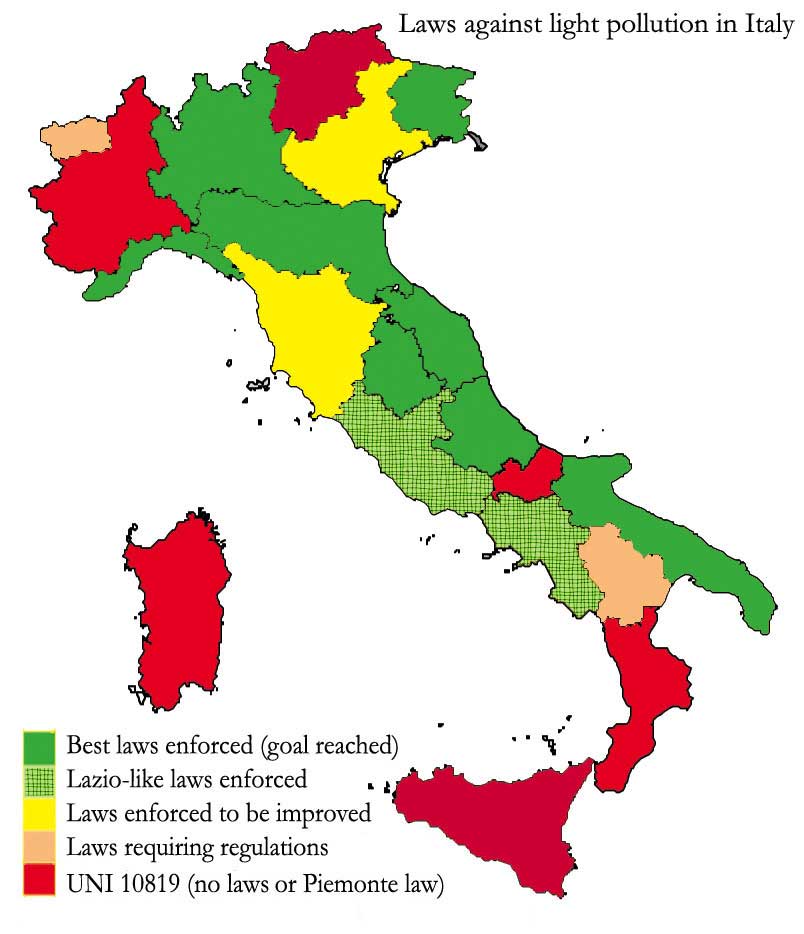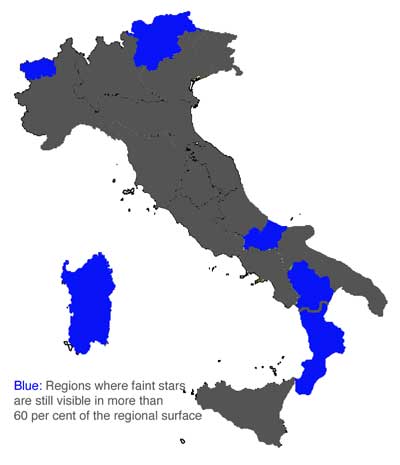Copyright 2000, P. Cinzano, Thiene, Italy
All rights reserved
Laws against light pollution in Italy
Regional laws against light pollution have been already enforced in 15 Italians regions (Lombardia 17/00, Emilia-Romagna 113/03, Marche 10/02, Lazio 23/00, Campania 13/02, Veneto 22/97, Toscana 37/00, Piemonte 31/00, Valle d'Aosta 17/98, Basilicata 41/00, Abruzzo 12/05, Umbria 20/05, Puglia 15/05, Friuli-Venezia Giulia 15/07, Liguria 22/07) which cover more than two thirds of the Italian population and the main cities (Milano, Roma, Venezia, Firenze, Bologna, Napoli). In addition, three Italian technical standard rules refers directly or indirectly to light pollution (UNI10819, UNI10439, UNI9316).

Effective technical criteria for an effective limitation of the effects of light pollution on the night sky brightness are properly enforced in these laws:
- L.R. Lombardia 17/2000 updated with D.G.R. Lombardia 2611/2000, L.R. Lombardia 38/2004 and the Regulations D.G.R. Lombardia 7/6162/2001,
- L.R. Marche 10/2002,
- L.R. Emilia-Romagna 19/2003,
- L.R. Umbria 20/2005,
- L.R. Abruzzo 12/2005,
- L.R. Puglia 15/2005
- L.R. Friuli-Venezia Giulia 15/2007
- L.R. Liguria 22/2007
These laws are in agreement with the demands of the organizations fighting light pollution. They are the most recent product of a continuous, accurate and successful update of a series of measures against light pollution proposed to the Italian parliament across several parliamentary legislatures, from the Bill n. 1296 in Senate in the XI legislature, to n. 511 in Senate in the XII legislature, n. 751 in Senate in the XIII legislature, n. 697 to the Chamber of Deputies in the XIV legislature, etc. These measures are reasonable and effective. Moreover, they are the simpler and easier rules to put into effect. See below a resume of the most important measures.
The laws of Regione Lazio and Campania are on the same line, but suffer of too large limits and a greater complexity of application and control because limits are different per kind of installation and per place.
The law of Regione Veneto n.22/1997 was the first law against light pollution enforced in Italy. Tuscany Region adopted a quite similar text few years later. This law has many defects and bugs. An update of its technical measures to those of the Lumbardy, Abruzzo, Puglia laws have been asked even by a popular petition. The leaflet "LR22/97: Urgente aggiornare" lists main problems of this law in Italian language.
The Italian standard rule UNI-10819 and the law of Regione Piemonte n. 31/2000 updated with the law n. 8/2004, which make reference to this rule, do not appear technically adequate to protect the night sky from light pollution. During the public hearing for a new Bill proposed in Piemonte, it was suggested by many parts to abandon any reference to such standard rule in laws against light pollution. Read more...
Finally, the law of Basilicata contains only generic requirements to adopt unspecified prescriptions against light pollution and the law of Valle d'Aosta recall a generic enforcement of rules against light pollution.
Only five Italian regions are still lacking of a law against light pollution (Sardegna, Sicilia, Calabria, Trentino-Alto Adige and Molise). To this list we should add Valle d'Aosta and Basilicata, whose laws do not contain specific measures, and Piemonte, whose law refers to an inadequate standard rule already enforced. Except Piemonte and Sicily, these regions are just those with the larger fraction of territory with reasonably dark sky. This is curious because we would expect that these regions are the most careful to preserve the environmental and turistical heritage, which luckily they still have. Probably the favourable situation drives the local administrators to underestimate the problem.

Resume of the primary technical measures against light pollution
Let’s resume the provisions to be adopted in an effective legislation against light pollution. Only the technical measures than cannot be renounced are listed here and only those already enforced and “experimented” somewhere. They should be part of a law and not postponed to following Regulations or Planes, because they should be stronger to win the resistances of the most unprogressive part of light polluters. Read more...
1) provisions should be applied in the entire territory without ineffective subdivisions in “protected areas” or poorly defined zoning because light pollution propagates very far from sources.
2) provisions need to be clearly applied to any NEW lighting installation, both public and private.
3) light pollution due to reflection by lighted surfaces should be limited by forbidding over-lighting and enforcing the use of flux reducers at the proper time or the shut off whenever possible. When a standard rule for safety exist, the average luminance or illuminance should not surpass the minimum value required for safety (e.g. road, walking areas, working areas). For other kinds of lighting a maximum luminance of 1 cd/m^2 should be permitted (e.g. building lighting).
4) limitation of direct upward emission produced by fixtures in any direction above the horizon, should be obtained by using a parameter depending on the direction of the light and not on the integrated light flux. A good parameter is the light intensity per unit of flux emitted by the light installation, in cd/klm. The light emissions at small angles above the horizon (the first 45 degrees) should be limited very carefully because they are the most effective in producing the adverse affects of light pollution.
5) the direct upward light emission of fixtures should be limited to 0 cd per 1000 lumens of flux emitted by the fixture, in any direction above the horizon (gamma angle equal or greater than 90 degrees) for almost any kind of lighting installation. A tolerance of 0.49 cd/klm is allowed in practice, because the limit is given as an integer number and then the measurements can be approximated to the nearest integer.
6) Building and monuments should be lighted from top to bottom, with the same limits given above for the upward lighting emissions, except in cases of proved impossibility (in this case it should be permitted to light from bottom but the border of the light beams should remain inside the boundaries of the lighted surface).
7) Lighting installations for large areas should complain to the same limits above (point 5).
8) Only lamps with the larger efficiency available for the requested use should be used. They save energy and produce less light pollution outside the photopic band and inside the scotopic band.
9) Upward directed light beams, beacons and similar luminous calls should be prohibited, even because they distract car-drivers and endanger the road safety.
10) Penalties for not compliant installations should be proportional to the number of fixtures.
11) The existing installations producing huge quantities of light pollution or belonging to the most polluting categories should be adapted.
12) The lighting design made by a professional lighting engineer should be mandatory for any lighting installation (except low power home installations with less than 5 fixtures). It should be completed with the photometries of fixtures in standard EULUMDAT format and a report demonstrating the numerical compliance with these rules.
The following prescriptions could also be added, whose precious effects of rationalization have already been pointed out: 1) the yearly growth rate of the installed light flux for nighttime outdoor lighting, public and private, in any municipal district cannot exceed the 2%; 2) the yearly growth rate of the electric power consumptions for nighttime outdoor lighting, public and private, in any municipal district cannot exceed the 1,5%; 3) the fraction of downward flux emitted by the lighting installation outside the surface to be lit should be accurately minimized as much as possible.
The limit on the yearly growth rate of the electric power consumptions for nighttime outdoor lighting has been recently enforced by law in some regions of Italy.
See the web site of Cielobuio, national coordination for the protection of the night environment, for many useful documents:
- Laws
- Regulations and explanations for the application of the laws
- Capitolati d'appalto tipo
- Catalogues of fully shielded fixtures
- Ordinances
- Examples of letters and judiciary complains